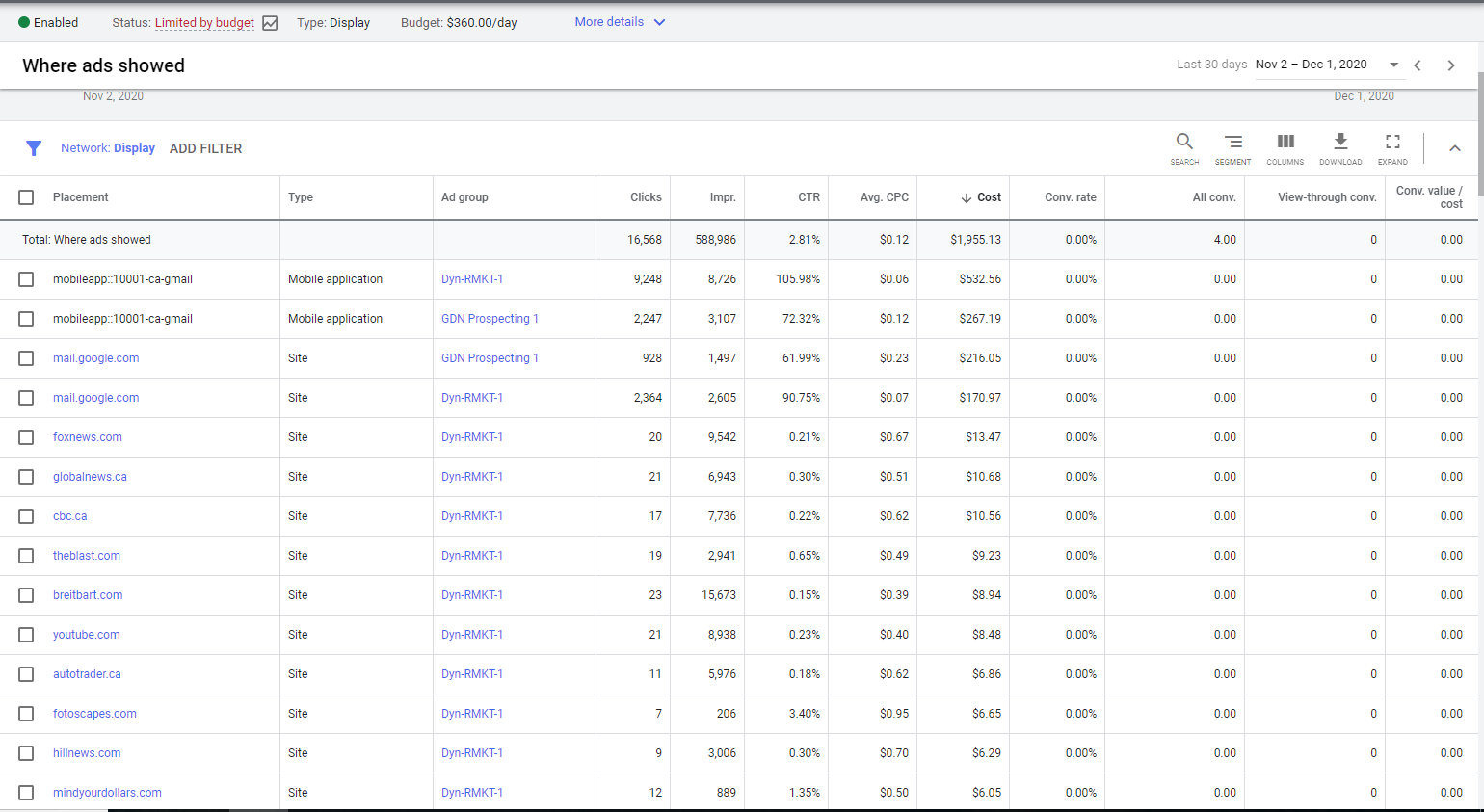
One of my favorite childhood books was The Large and Growly Bear. It’s a cute way of learning how a bully boxes himself in and how the rest of us are better off going about our business rather than trying to appease said bully. This bear goes around trying to scare the birds, moles, and rabbits, but they’re too busy catching worms, singing, digging, and jumping to bother being scared. In the end, the bear can only find one creature to scare: himself.
As Google gained dominance in the field of digital ad auctions amenable to bidding from a platform, it seemed plausible back in the day that they would come to expand their realm to credibly cover more and more ad inventory like TV, radio, out of home, etc. – let alone the already-digital world of display advertising.
It didn’t work out that way. The reason? Google would have had to partner stably with the owners of many audience assets out of their control. But in the intervening years, Google went around scaring everybody. Encroaching on verticals that it formerly had no interest in. So when it came time to expand their empire by folding more and more media into that which took a cut from advertisers, potential partners thought twice. And the rest of us, preferring to play, sing, dig, and jump in our own way didn’t feel deprived when it felt like some advertising opportunities wouldn’t force us to have a conversation with Ol’ Growly.
When it comes to their own properties – Search, Gmail, YouTube, and some others – Google has no issues. They’re inherently popular and valuable to advertisers, so they’re a cinch for Google to monetize.
When it comes to the overall market for Display advertising, to say nothing of similar opportunities on connected screens, radio, and so on, it’s a different story. The “rest of the world’s eyeballs” are falling farther out of Google’s grasp, not being bear-hugged deeper into it. Controlling all the eyeballs is apparently a bit like herding all the cats.
A senior executive in the world of today’s DSP’s (Demand-Side Platforms) recently said this of the Google Display Network: “GDN is for specialists in Search advertising who want an easy way of buying display using the same platform.” And just today in conversation with me, he added: “Like any stepping stone, once you move off it, you never step on it again.”
Perhaps that’s why this method of achieving reach on top of a more targeted keyword advertising campaign is so often found wanting.
Smart or smarmy?
You’ll notice, if you work closely with Google, a relentless focus on innovation in targeting methods, complete with cute names beginning with Smart, Discovery, Smart, and, hmmm, there’s also Smart, and Trueview (?). Today, I audited a typically hapless small e-commerce account and noted the heavy (and in some ways, unwitting) use of automation, including Smart settings that provide an unknown dollop of Display advertising and an unknown dollop of users who have high intent because they’re existing customers (i.e. it’s really remarketing). Innovative targeting methods are nice in theory, but the underlying quality of the ad inventory, the nature of the audiences targeted, and the transparency of reporting, make advertising more or less fruitful in reality for any business investing in it.
Display ad fraud experts aren’t fans of everything Google does. But if you put them head-to-head against certain well-known competitors, the same experts will point out more often than not that the competitor is not only worse than Google, but tragically and cynically so. And thus, the low bar is set.
Blending traffic streams that should be handled distinctly, and calling it all Smart (“the bots know”, “AI is incredibly effective if you have enough data,” etc. claims are used as red herrings to mask parlor tricks) has landed slick-talking upstarts in the programmatic world, such as Rocket Fuel, in career-limiting hot water. Hiding and covering up the blending blew Rocket Fuel’s credibility. Google, it seems, thinks of itself as even slicker. So slick you don’t think they’re slick. But hiding the banana doesn’t sit well with those of us who like full-featured reporting on how targeting works.
There is a certain class of practitioners – purveyors of sizable swaths of BS at large agency holdcos – who love adtech terminology, and are fine with the notion that Google comes up with all these ways of selling non-performing media. After all, clients of large agencies have enormous budgets to spend on advertising. They have to put it somewhere. And until shown otherwise, Google’s brand plays well in the C Suite. They ask for it by name. The agency obliges.
Big agencies love it when their business units can achieve “results” with a minimum of effort. The reduction in effort squares with the general trend of large agency holdcos, which is to consolidate, reduce headcount, emphasize low-salary and contract execution of functions, etc. (Lather, rinse, repeat. This is how the big agencies’ never-ending growth-by-acquisition method leads to efficiencies in order to please Wall Street.)
Are you in a senior role at one of these agencies? Your choice may very well be to start your own boutique agency, or become an Uber driver. Perhaps you could run a quaint B&B when the pandemic is over.
Consider credibility
Of course, the bedrock of credibility in any digital advertising channel isn’t too hard to identify: it comes down to (highly) detailed reporting, and unbiased attribution credit for driving important outcomes and secondary KPI’s alike.
There is another – common-sense, perhaps – aspect to credibility. “Brand safety” is a buzzword that speaks mainly to the worst-case scenario of losing face when your ads start showing up next to online content that offends or looks tawdry. But whatever happened to the basics of feeling a strong affinity for a publication because its prestige is consonant with the way in which the advertiser likes to be positioned? All the glorious old magazine titles we remember classy people leafing through back in the day, for example. Some niche (Cigar Aficionado, Road & Track), some lifestyle (GQ, Vanity Fair), but always glossy, always prestigious. The folks who took out classified ads might have got more measurable performance, but there was always demand for the pure affinity of the association with the content. You don’t measure everything in the same way. Every week on the PGA Tour, there’s a company that’s willing to lay out silly money to have a whole weekend named after them. Prediction: that isn’t going away.
Programmatic, done well, is far from that “leadership from the gut” approach. Indeed, it might be the perfect blend of accountability, reach, and brand safety (or whatever a more appropriate term would be than the low-bar concept of “brand safety,” such as affinity-aware advertising, or brand dignity).
If you’re of that mind, and want to show up in more prominent positions in more prestige (online) properties, the minimum spend probably isn’t as exclusive a club as you think. So, if you want to advertise like a grownup with some modicum of choice and autonomy, your days of negativing Breitbart and randomrussianchatboard.ru out of your Google Ads GDN placement report (if you even get a placement report) could be over. It could be a stepping stone you don’t care to step on ever again.

Figure 1: The usual pastiche of placements in the GDN “Where Ads Showed” report. The approach to transparency is best described as “translucent.”
Let’s be as lenient as we need to be here. We know that mass advertising is an awareness medium, and at some level, it does work. But we need to be a tiny bit skeptical in the online world, just as some fragment of fair play did come into the traditional advertising world in the form of, say, Nielsen ratings or the Audit Bureau of Circulations. We need to know not only that people saw an ad (without access to brain scans, “impressions” just don’t cut it). We shouldn’t be all impressed if an ad is served “above the fold” – how low does the bar have to be that some players, Google among them, seem to want a dog treat and belly rubs just to acknowledge the fact that they focus on charging you for ads that may actually occur in the target customer’s line of sight?
With all that being said, if we’re lenient and we just want to buy gobs of media awareness to supplement our more targeted (and much more expensive per interaction) campaigns, let’s insist on a certain amount of provable response: (1) a human pulse; (2) not toddlers fat-fingering a game app; (3) an actual click where, some of the time, the actual people come to the website and have a look-see and maybe even spend some time there, i.e. bounce rates that indicate some level of mild interest consonant with the keen targeting effort that should have gone into the media buy.
But there is a big (4). Give me access to a wide variety of bona fide, often superb quality publications not owned by the platform owner (i.e. Gmail and YouTube are fine, but that’s not the wide open Internet), and don’t confine me to tiny remnants but rather give me broader access so I can reach the kinds of consumers I’d like to reach, in an environment that a media planner can intuitively understand by harkening back to the days of TV shows, magazines, and billboard ads.
These old methods have their flaws, but being tangible examples of something we know someone is probably going to look at – and being able to prove it by running a real-world test (that is, driving by some large billboards, slowly flipping through a magazine, etc.) – isn’t one of them. Indeed, the harder today’s publishers and platforms work to keep us from the intuitive inventory, the more jargon they need, the more references to AI and finding the right users who “are more likely to convert,” etc., the more suspicious I get. I would absolutely love it if the technology was always just helping us with better targeting. Unfortunately, more often than not, it’s (1) just masking poor or fraudulent underlying inventory, and (2) relentlessly finding ways of showing ads not to new people in a disparate range of intuitive well-lit spaces, but sneaking in the perennial trick of showing ads to people who already know about our company, already do business with our company, or are talking trash about our company because they’re upset about our company. Remarketing has its place. But it’s not always what we’re seeking. Unfortunately, that’s what we wind up getting unless we have credible reporting, understand intuitively where and how our ads will be showing, and are operating under fair, non-parlor-trick attribution models.
Easy optimization has evaporated
For years, I’ve tried to squeeze performance out of the Google Display Network. The primary means of doing that has been (duh) optimization. This won’t work for every business model, but in days gone by, there were some pretty straightforward ways of trolling for converting inventory, analogous to using broad match or DSA in a keyword campaign to discover more specific nuggets of converting traffic (note that Google recently put a serious wrench in this, too, by severely throttling the availability of search query data in our reporting).
Essentially, until a couple of years ago, you could run moderately broad GDN campaigns using some intuitive targeting methods to train your sights on the types of “placements” (whole domains, or pages within them) that might be relevant to your business’ offering. If done carefully, you might discover that 20% of these worked and hit close to your target KPI. 80% wouldn’t. From there, we had incredible control over bid adjustments for all the individual placements! Three basic steps were required:
- Move the promising placements over to something called Managed Placements and begin bidding them on their own to ensure you’re able to serve your ads in these promising places.
- Continue running the broad-brush campaign (in what was called Automatic Placements) and periodically move promising placements over to Managed Placements, while bidding so-so placements down.
- Exclude non-performing placements periodically as more data comes in.
And when mobile app inventory (99.9% non-performing for our clients’ purposes, and probably yours) came on the scene, no problem! Those in the know could exclude all of it by excluding just one “master” placement: adsenseformobileapps.com
Unfortunately, it doesn’t work that way anymore. If you don’t want your entire placements list to be littered with mobile app inventory (that noxious species of “ad” spend that invades a campaign like Giant Hogweed), you’ll need to take a fantastic journey into Tools > Placement Exclusion Lists, and figure out how to negative out upwards of 140 app categories, split between Android and iOS. Watch out! Some of them are nested. You’ll want to get them all, in most cases.
Beyond that, the ease of moving promising placements over to Managed Placements in a seamless, data-driven manner has evaporated. Guess this wasn’t profitable enough for Google. Plus, the GDN is something of a black box, and often has access to only second-rate or remnant inventory. Google papers over this fact by trying to peddle various Smart (black box) targeting and bidding methods that may smuggle in high-intent audiences (i.e. your remarketing audiences), which severely muddles the value of what would otherwise be perennially non-performing segments.
If we want business growth and a way of accessing more ad inventory in the wide-open Internet, there’s no reason we have to limit ourselves to Google’s proprietary tinker-toy version of that.
So there’s your rationale for looking beyond GDN, despite the enormous general credibility Google has established. Oh, they’ll be all growly about it. But you’ll be too busy digging, singing, and catching worms.
In a couple of weeks, I’ll return with specific ideas in a piece entitled “Life Beyond GDN: Some Ideas.”
Read Part 32: Click Fraud: Is Third-Party Detection Software the Answer?